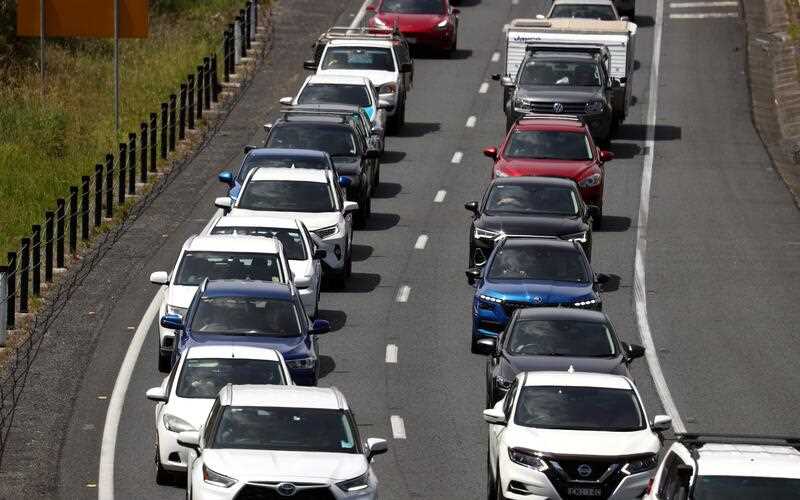Australia has a weight problem, experts warn, and it has less to do with what we put in our mouths than what we put on our roads.
The average weight of cars in the country is rising, with the two top-selling vehicles among the heaviest on the market and SUVs and utes making up more than three in every four cars sold in Australia.
The trend, partly fuelled by tax incentives, could impact on passenger and pedestrian safety, they say, as well as pollution and is likely to come under greater scrutiny as motorists transition to electric vehicles.
But others argue it is not passenger vehicles but a new generation of trucks that could do damage to roads and bridges, and need greater scrutiny and research before their wide adoption.
The physical burden of vehicles in Australia has been steadily climbing for more than a decade, with new vehicles now weighing an average of 2.05 tonnes.
Figures from the Federal Chamber of Automotive Industries show heavier SUVs made up more than half of all vehicles sold last year, at 53 per cent, while substantial light commercial vehicles such as utes represented 23 per cent of vehicles sold in the country.
An industry insider, who asked not to be named, said rising vehicle weights were not something many in the automotive industry wanted to address, even though some pointed a finger of blame at electric cars.
“Three quarters of Australia’s new car market is SUVs and utes and that didn’t happen overnight,” they say.
Griffith University lecturer Anna Mortimore says financial incentives had fuelled the trend, such as fringe-benefits tax cuts for utes.
“We’ve had a huge uptake of large utes and that’s probably what’s going to be a difficult area to rein in,” she says.
“The popularity of utes needs to be addressed some time between now and 2030.”
Utes currently represent the two most popular new vehicles in Australia, the Toyota HiLux and Ford Ranger. Both of these vehicles are also among the heaviest on the market, weighing more than three tonnes each.
Even though they are regularly blamed for weight issues, the two electric cars ranking among the top 10 sellers weigh significantly less, with Tesla’s Model Y at 2.4 tonnes and MG’s ZS EV at 2.06 tonnes.
iMove Australia managing director Ian Christensen says despite their use of dense batteries, electric vehicles could lighten the burden on Australia’s roads if consumers chose to swap utes for modest SUVs.
“If, for some unexpected reason, people decide to give up their HiLuxes for small electric ones, you would get a big reduction in weight but that’s not coming from vehicle technology but consumer choice,” he says.
“If consumers continue to act in the way they have for the past decade, they’re going to buy a battery-powered HiLux or (Chevy) Colorado and it will be heavier than the diesel vehicle they are replacing.”
Rising vehicle weights are seen as a safety issue by some, Mr Christensen says, as greater weight makes vehicles harder to stop and brings more energy into accidents.
The issue is not new to vehicle manufactures, he says, which are seeking to mitigate the risk by adding greater safety features to modern vehicles, such as crumple zones, airbags, and autonomous braking.
“There is a body of skill available to vehicle manufacturers that will enable them to design heavier vehicles to still be safe,” he says.
“I’m not unduly concerned we’re going to unleash a torrent of catastrophes simply because more energy will be present in collisions.”
But Australian Electric Vehicle Association national president Dr Chris Jones says both manufacturers and policymakers should take action to reverse growing vehicle girth.
German automaker BMW proved electric vehicles need not break weight records when it released the i3 hatchback weighing 1.2 tonnes, he says, and other brands should follow its lead.
“It’s an engineering challenge to get electric vehicles of satisfactory range light enough but that’s a challenge manufacturers need to embrace,” he says.
“There’s no reason manufacturers can’t keep pushing that boundary because we really do need lighter and smaller vehicles.”
Another way to stem rising vehicle weight, he says, would be to change the way motorists pay for roads.
The association has previously recommended a “mass multiplied” road user charge that see all drivers pay for how many kilometres they drive each year, multiplied by the weight of their vehicle.
Under the scheme, driving a heavy ute or a large electric vehicle for long distances would cost owners more.
“You could still choose to buy a Toyota LandCruiser as the family car but it would cost you substantially more than if you bought a Holden Barina,” he said.
“People would have to think about weight when they buy a vehicle.”
A more pressing issue, Mr Christensen says, will be how Australian roads deal with even heavier vehicles: battery-electric trucks.
Australia’s bridges, roads and overpasses were not necessarily built to hold as much weight as some of the new freight vehicles, he says, and would demand immediate attention from transport researchers and policymakers.
“We will have to allow heavier trucks on the road otherwise there’s no way we can adequately decarbonise transport but we’ll have to be watchful for damage and get truck operators to avoid taking their heavier trucks over roads and bridges that are unable to bear their weight,” he said.
“Certainly, the adoption of electric trucks is more advanced overseas so we can look to other countries to see their experience.”
By Jennifer Dudley-Nicholson in Brisbane



